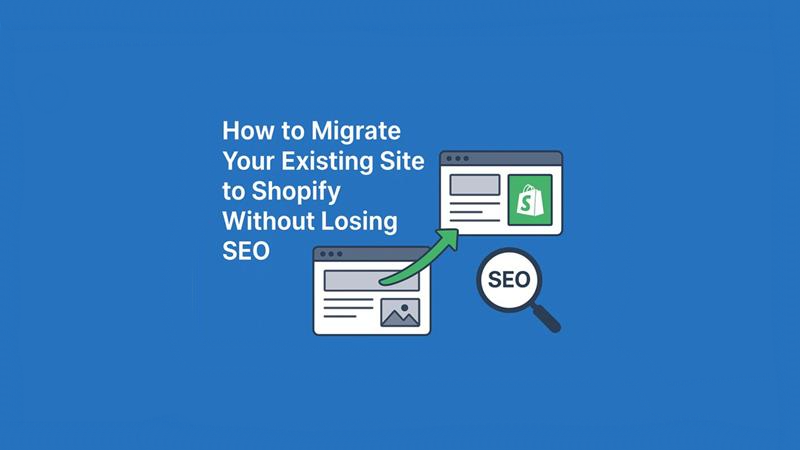
How to Migrate Your Existing Site to Shopify Without Losing SEO
Migrating your online store to Shopify is a smart move if you want a powerful, user-friendly, and scalable eCommerce platform. But many business owners worry about one thing: losing SEO rankings. Search traffic is often the lifeline of an online business, and a poorly managed migration can harm visibility in Google and other search engines.
The good news? You can migrate smoothly without losing SEO if you plan properly and follow the right steps. This guide, written with input from Shopify experts developers, explains how to move your website to Shopify safely, while protecting and even improving your search visibility.
Why Migrate to Shopify?
Shopify is a leading eCommerce solution trusted by startups, growing brands, and enterprise-level businesses. Some key reasons businesses choose Shopify include:
- Ease of use – Manage products, orders, and payments without technical hassle.
- Professional Shopify website design – Thousands of themes and custom options.
- Scalability – Handles high traffic and large product catalogs.
- Secure hosting and payments – No need for extra servers or plugins.
- Wide integrations – From marketing apps to third-party logistics.
By working with a Shopify development company, you can make sure your store setup, SEO, and migration are handled by professionals.
Common SEO Risks During Migration
Without a clear plan, businesses often face:
- Lost rankings due to broken links or missing redirects.
- Different URL structures that confuse search engines.
- Missing metadata (titles, descriptions, alt tags).
- Duplicate content issues.
- Slow site speed if not optimized.
That’s why Shopify SEO services are so important during migration.
Step-by-Step Guide: Migrating to Shopify Without Losing SEO
1. Perform a Full Website Audit
Before moving, audit your existing website. Record:
- All current URLs
- Meta titles and descriptions
- Blog posts and product pages
- Backlinks and referral traffic sources
- Top keywords bringing in traffic
This audit acts as your blueprint for migration.
2. Choose the Right Shopify Plan and Setup
Select a plan that fits your business needs. While smaller stores can start with Basic Shopify, larger businesses may need Advanced Shopify for better reporting and features.
Next, work with a Shopify web designer or Shopify development services provider to build a store that reflects your brand and enhances user experience.
3. Map and Redirect URLs
Shopify has its own URL structure. To prevent broken links and SEO loss, set up 301 redirects from your old site to your new Shopify URLs.
This step tells Google your content has moved and helps preserve rankings.
Ready to Migrate Your Site to Shopify?
Our Shopify experts developers provide end-to-end Shopify development services – from seamless site migration and Shopify SEO optimization to custom Shopify website design. Keep your rankings and grow your sales with a trusted Shopify development company.
4. Migrate Content Strategically
Move your:
- Product descriptions and images
- Blog articles
- Category and collection pages
Keep keyword-rich content intact, and make sure images have alt tags. A professional Shopify SEO company will also ensure structured headings (H1, H2, H3) are optimized for search engines.
5. Optimize for Shopify SEO
Once your content is live on Shopify, update and refine:
- Meta titles & descriptions
- Internal linking
- Navigation menus
- Schema markup
- Mobile responsiveness
Use long-tail keywords like “best Shopify development company for migration” or “Shopify SEO-friendly website design” naturally in your content.
6. Set Up Analytics and Monitoring
Add Google Analytics and Search Console to your new Shopify site. This lets you monitor traffic, keyword performance, and indexing issues right after launch.
7. Test Before Launching
Before going live, test your site for:
- Redirect accuracy
- Mobile optimization
- Page speed
- Checkout functionality
A professional Shopify developer can ensure your site is fast, secure, and user-friendly.
8. Launch and Monitor SEO Performance
After launch, track rankings, traffic, and conversions closely. If you see drops, revisit your redirects, metadata, and sitemap. With the right Shopify SEO strategy, rankings typically bounce back and even improve over time.
Frequently Asked Questions
1. Will I lose my Google rankings if I switch to Shopify?
Not if you plan correctly. With proper URL redirects, metadata preservation, and professional Shopify SEO services, your rankings should remain stable.
2. How long does it take to migrate to Shopify?
The timeline depends on the size of your website. A small store may take a week, while larger sites with thousands of products may take several weeks.
3. Can I migrate my WordPress or WooCommerce site to Shopify?
Yes. Many businesses move from WooCommerce, Magento, or WordPress to Shopify. A Shopify development company can handle product data, orders, and SEO elements during migration.
4. Do I need a Shopify expert to migrate my site?
While you can do it yourself, hiring Shopify experts developers ensures you don’t lose SEO traffic or run into technical errors.
5. What Shopify SEO services are most important after migration?
Key services include keyword optimization, fixing redirects, updating product descriptions, image SEO, and continuous monitoring of rankings.
Final Thoughts
Migrating your store to Shopify can feel overwhelming, but with the right strategy and expert help, it’s a smooth process. By planning carefully, protecting your SEO, and investing in professional Shopify development services, you’ll not only keep your rankings but also create a stronger foundation for growth.
Are you planning to move your store to Shopify? Don’t risk losing your SEO rankings. Our team of Shopify experts developers offers complete Shopify development, Shopify website design, and Shopify SEO services to make migration seamless.
Contact us today for a free consultation and migrate with confidence.
Get A Quote
Reach Out and Bring Your Visions to Life
Get A Quote
Reach Out and Bring Your Visions to Life

